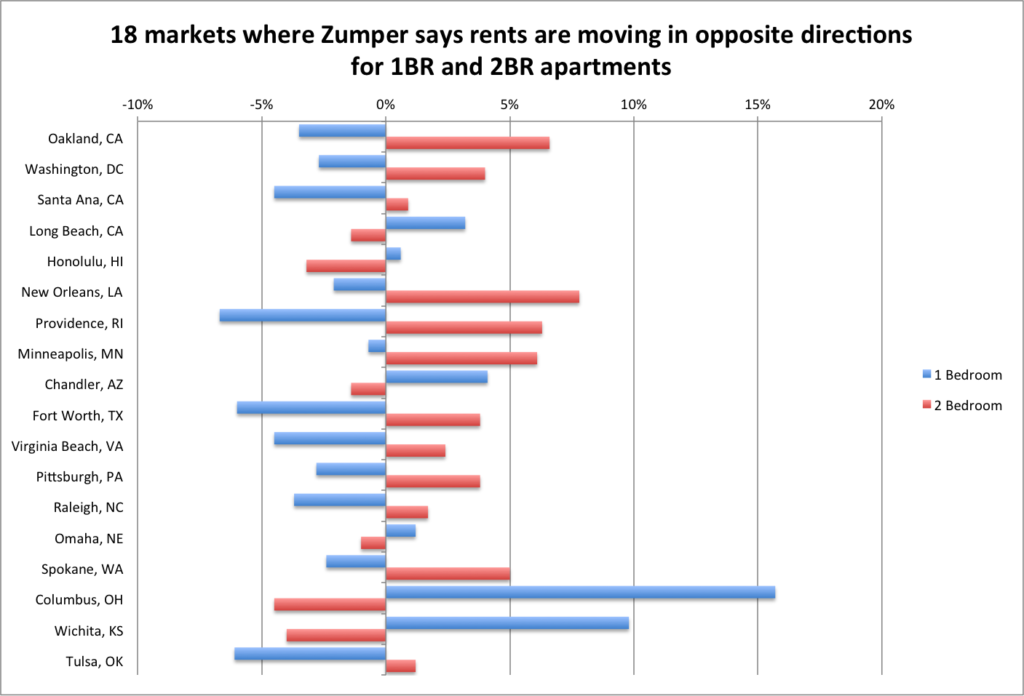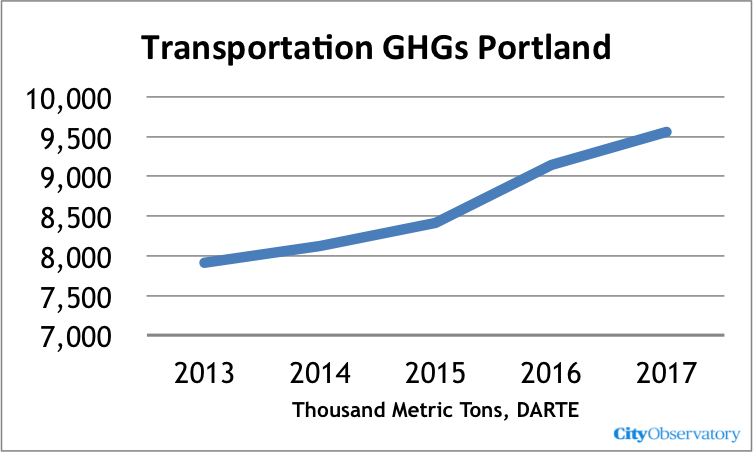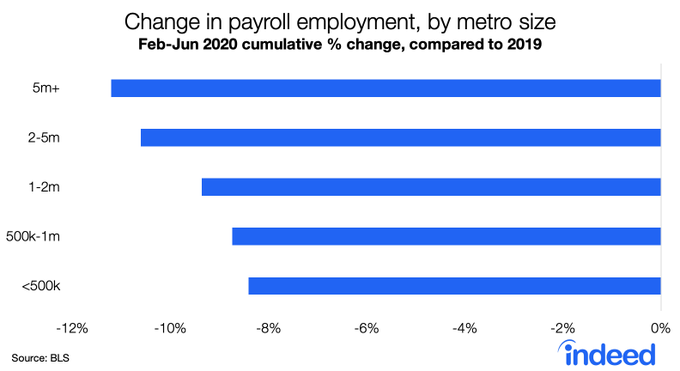What City Observatory did this week
1. Is it random, or is it Zumper? Are rents going up or down in your city? Listicles showing which places have the biggest jumps (or declines) in rents are a perennial media favorite, but as we’ve warned before, when it comes to data on rent changes, caveat rentor. We once again sift through Zumper’s claims about rent trends, and find that their methodology (which is subject to composition effects) produces inexplicable deviations in trends for one-bedroom and two-bedroom apartments in the same market in about a fifth of metro areas.
 It’s implausible to suggest, as Zumper’s data claims, that rents on two bedroom apartments in Columbus are down 5 percent while rents on one bedrooms in the same market are up 15 percent over the same time. There are better behaved and more reliable sources of rent data.
It’s implausible to suggest, as Zumper’s data claims, that rents on two bedroom apartments in Columbus are down 5 percent while rents on one bedrooms in the same market are up 15 percent over the same time. There are better behaved and more reliable sources of rent data.
2. Self-proclaimed climate leaders shouldn’t spend $5 billion on transportation to reduce greenhouse gases by 5/100ths of one percent. Portland’s regional government, Metro, will ask voters this fall to approve a $5 billion dollar transportation measure, but despite the fact that it claims to care about climate change, and transportation is the biggest and fastest growing source of greenhouse gases in Portland, this package does essentially nothing to reduce emissions.
At a time when we all recognize the growing climate emergency, dedicating a huge chunk of revenue to projects that don’t move the needle on greenhouse gas emissions is a tragic mistake.
Must read
1. The Covid-19 Recession is hitting big cities harder. Jed Kolko, Chief Economist for Indeed has parsed BLS job-loss data by metro size to show the differential impact of the recession. The key takeaway: job losses have been proportionally greater in the largest metros. Metro’s with 5 million or more population have lost more than 11 percent of their jobs, compared to between 8-9 percent for metros under a million.
The reason likely has a lot to do with the knock on effects of the varied ability of people to work from home in large metro areas. While the people who work from home are able to keep their jobs (and paychecks) the businesses that depend on them purchasing services–think restaurants that cater to the lunch-trade, or business travelers–are harder hit in these metros. Looking at Indeed’s own data on new job postings, Kolko explains:
In sectors that serve local customers in person, job postings have fallen more in metros where people are more likely to have jobs that can be done from home, allowing them to practice more physically distancing. Job postings in these in-person service sectors — retail, food preparation, sales, and beauty & wellness — have fallen more in metros where people are more likely to work from home, like San Francisco, Washington, Boston, and Seattle.
There’s an important lesson about economic linkages here: While work-at-home is good for those who have the opportunity, it doesn’t insulate other workers in service industries from the downturn. That’s why comprehensive policies, like enhanced unemployment insurance benefits are critical to keeping the economy from auguring downward.
2. Europe agrees to implement a carbon border tax. In 2023, the member states of the EU have agreed to implement a carbon border “adjustment fee” that effectively adds the price of embedded carbon emissions into goods imported from other countries. A domestic carbon tax is a useful first step, but to make sure that a nation doesn’t disadvantage local producers, and simply end up exporting its carbon footprint, the border adjustment fee makes sure that consumers see the price of carbon in goods regardless of where they’re made. The fee will increase incentives to decarbonize within and beyond the EU, as those seeking to tap the European market will want to reduce carbon intensity to lower their likely fees. Some worry that this disadvantages lower income countries, but nation’s imposing the carbon fee could easily use at least some of the revenue to finance more generous foreign aid, rather than forcing less developed nations to depend on dirty industries to escape poverty.
3. Looking for patterns in the rent slowdown. Since the onset of the pandemic in the Spring, rental markets across the nation have softened, and Zillow reports that nationally rents are down about one and a half to two percent in the past few months. Zillow focuses in on the city/suburb variation in these patterns and reports that the rent slowdown has been more pronounced in urban areas than their surrounding suburbs, although so far, the differences are generally small, and the patterns doesn’t hold for all metro areas. Rents have decelerated most sharply in the centers of New York, San Francisco and Dallas compared to their surrounding suburbs. Nationally, urban centers have seen roughly a 2 percent deceleration; suburbs about a 1.5 percent deceleration. But some cities show the reverse pattern: in 14 of the 34 markets Zillow studied, the city deceleration was less than in the suburbs, including Philadelphia, St. Louis, Baltimore, Portland, Cleveland, and Minneapolis.
New Knowledge
The costs (and benefits) of inclusionary housing requirements. MIT economist Evan Soltas has a new paper estimating the costs and benefits of inclusionary housing policies which should be of tremendous interest to everyone interested in affordable housing. Cities around the country have a variety of policies that incentivize (or require) that developers include a certain portion of affordable housing units in new developments.
Voluntary programs offer developers financial incentives to participate, and its possible using variations in the terms of those programs over time and space to compute just how much subsidy one has to provide to get developers to participate. Soltas uses New York’s property tax exemption program (called 421a) to measure how much it costs (in foregone tax revenue) to prompt developers to build an additional unit of affordable housing. City-wide, Soltas finds that the city has to forego about $1.6 million in property tax revenue for each additional affordable unit.
But there’s much more to the story. The cost varies widely across neighborhoods in the city, with even higher subsidies needed in expensive locations, and far smaller ones in lower income neighborhoods. And cost isn’t the only important factor at work here: one objective of the inclusionary programs is to create more opportunities for low income households to live in high opportunity neighborhoods. Soltas taps data from the Equality of Opportunity project’s estimates of the impact of neighborhoods on lifetime earnings of low income kids to estimate how much they gain from living in different neighborhoods. Even though its cheaper to subsidize units in some neighborhoods, the long term cost to kids in terms of lower lifetime earnings makes this a bad bargain. And while the most expensive neighborhoods (in Manhattan) produce greater benefits, they aren’t worth the costs. Soltas does identify some “opportunity bargains” places that are relatively cheap to get more affordable units, and which provide better lifetime opportunities for kids.
All this suggests a couple of key findings: First, inclusionary housing programs aren’t free, or even particularly efficient, at a city-wide cost of $1.6 million per additional unit. Second, it makes a huge difference to both the costs and benefits of inclusionary programs where in a city these units are built. Few strategies have given much thought to how to tailor incentives to minimize costs while maximizing benefits.
Evan Soltas, The Price of Inclusion: Evidence from Housing Developer Behavior, July 2020.
In the News
City Observatory director Joe Cortright presented the results of our recent study, Youth Migration, Accelerating America’s Urban Renaissance, for a webinar sponsored by the Manhattan Institute. Full video available here:



